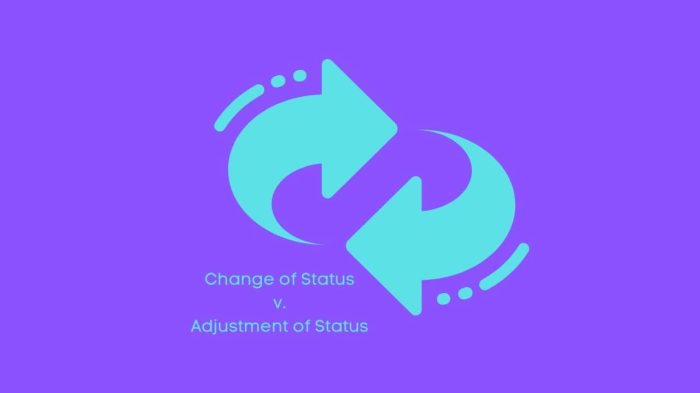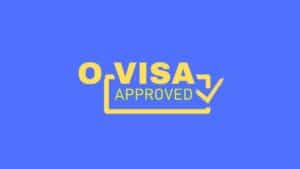Introduction
Suppose you plan to travel to the United States on a nonimmigrant visa. In that case, you should know the difference between a change of your status and an adjustment of status. It is essential because many people mistakenly believe their meaning to be the same while they are not. In simple words, Adjustment of Status (AOS) aims towards adjusting your status as a lawful permanent resident, while the change of status is changing your nonimmigrant status to another nonimmigrant status. Let us try to understand the meaning of each term separately and in more detail.
Change of Status vs. Adjustment of Status
What do you mean by Adjustment of Status?
Do you want to go to the United States on an immigrant visa and get a green card? If you are applying from outside the US, you have to go through consular processing. The harsh truth is that this process can take some time, and you have to wait until your visa is approved to enter the US. Therefore, many people choose a different route.
If you want to enter the US, the fastest route is to get a nonimmigrant visa and travel to the US. Once you are in the United States on any nonimmigrant visa, maybe in the future, you get your chance to apply for an immigrant visa. When you apply for an immigrant visa in the US while on a nonimmigrant visa, you adjust your status. Adjustment of status means changing your status to a legal permanent resident while on a nonimmigrant visa in the United States. The two most common routes through which people adjust their status are:
Family-Based green card route
The sponsor (US citizen or lawful permanent resident) has to file an I-130 petition to establish a relationship between you and them. Approval of the I-130 petition does not provide any immigration benefit. After your I-130 petition is approved, you have to file Form I-485. Suppose you are in the United States and a visa is available for you. In that case, you might be eligible to get a Green Card by filing Form I-485, Application to Register Permanent Residence, or Adjust Status. If your Form I-485 is approved, you will get a green card. This is called Adjustment of Status.
Employment-Based green card route
Similarly, you can adjust your status through the employment route. A US employer (sponsor) will sponsor you by filing Form I-140 (Immigrant Petition for alien worker). Once your I-140 petition is approved, you can file Form I-485 to adjust your status if a visa is available for you. You will have successfully adjusted your status after your Form I-485 is approved.
Other than these two routes, you may adjust your status under special circumstances like asylum or refugee.
What do you mean by change of status?
Mistakenly, many people believe the terms “adjustment of status” and “change of status” are interchangeable. It is absolutely not true in the context of US immigration law. As discussed above, Adjustment of status refers to adjusting your nonimmigrant status to lawful permanent resident status, while changing of status means changing your nonimmigrant visa status while in the US.
For example – You come to the US on a tourist visa, say B-2, and during your stay in the US, a US university gives admission to you, and you want to apply for a student visa. You can apply to the USCIS to change your nonimmigrant status while maintaining your current visa status.
You should be very careful to change your status while maintaining legal status in the United States. If, before your application for change of status is approved, your current visa expires, you have to leave the US, unfortunately, and apply again from your home country. Unless, in certain cases, you file the change of status application before the expiration of your current status. You should always consult with an immigration attorney to make sure this applies to your case before relying on this exception.
Certain nonimmigrant categories do not allow you to change your status, such as C, D, and K visas. Consult an immigration attorney to assess your case carefully. Further, if you have entered on ESTA, you are also not permitted to change your status.
How can I file for a change of my nonimmigrant status?
To change your nonimmigrant status, you have to file Form I-539 (Application to Extend/Change Nonimmigrant Status) and submit the fees to the USCIS. The filing fee for I-539 is $370, and in addition to that, you also have to pay $85 as biometric service fees.
What if my change of status application is pending. Can I engage in other activities?
If you have applied for a change of your nonimmigrant status, USCIS might take some time to process your application. In that time, you are only allowed to engage only in those activities you are permitted under your current visa. You may face trouble if you do activities that you are non allowed to do on your current status.
For example – You have traveled to the US on a tourist visa. A US employer is ready to sponsor you for an employment visa, and you decided to apply for a change of your nonimmigrant status. You cannot join employment and work in the US unless a decision is made on your application. If the USCIS approves your change of status application, you can then work in the US; otherwise, you have to leave the US after your current status expires.
Conclusion
I hope you are clear with the terms “adjustment of status” and “change of status.” Suppose you are in the process of adjusting or changing your status and need expert help. In that case, you can contact the Sethi and Mazaheri law firm. Our experienced immigration attorneys will reach out to you and assist you with your immigration application.








 by Prozco®
by Prozco®